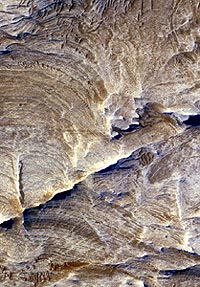 Light-colored mineral deposits
Light-colored mineral deposits
in Candor Chasma that may be evidence
of past underground fluid flows on Mars.
Credit: NASA/Mars Reconnaissance Orbiter.One of the most profound, and as yet unanswered questions about our universe is, does life exist elsewhere than on Earth? To attempt to answer this question, scientists are looking to places within the reach of our ability to explore--within our Solar System--that may harbor environments, past or present, suitable for life as we know it-- life dependent on the presence of liquid water.
Two key developments in recent years have elevated the possibility of actually finding extraterrestrial life: the unearthing of so-called "extremophile" life forms on Earth that thrive in conditions of extreme heat, cold, and toxicity--under polar ice, around geothermal hot springs, and in the dark depths of the ocean around volcanic vents--and the discovery of liquid water beyond Earth.
Recently, NASA’s latest robotic spacecraft to reach Mars--Mars Reconnaissance Orbiter-- sent back an image that may contain evidence that liquid water once flowed there. The image revealed light-colored, slightly elevated veins and steaks in the canyon named Candor Chasma--evidence, scientists believe, that fluid may have flowed there underground, leaving behind deposits of hardened, lighter colored minerals now exposed by eons of erosion.
On reading about these exposed, raised deposits, I recalled stumbling upon a possible analog here on Earth. In the deserts of Northern Arizona I found long, meandering ridges of stone, rising a foot or two above the sandy plains. These were, my guide to local geology stated, "fossil" stream beds where sandy sediment once built up and ultimately became compacted into hard sandstone.
Many scientists suspected that Mars had liquid water on its surface sometime in the remote past, but it wasn’t until data sent back by such spacecraft as Mars Odyssey, the Mars Exploration Rover Opportunity, and Mars Global Surveyor not only confirmed that suspicion, but more excitingly produced evidence that liquid water may exist on Mars today, flowing through underground aquifers and erupting occasionally from the sides of crater walls and cliffs in brief, though violent flash floods.
